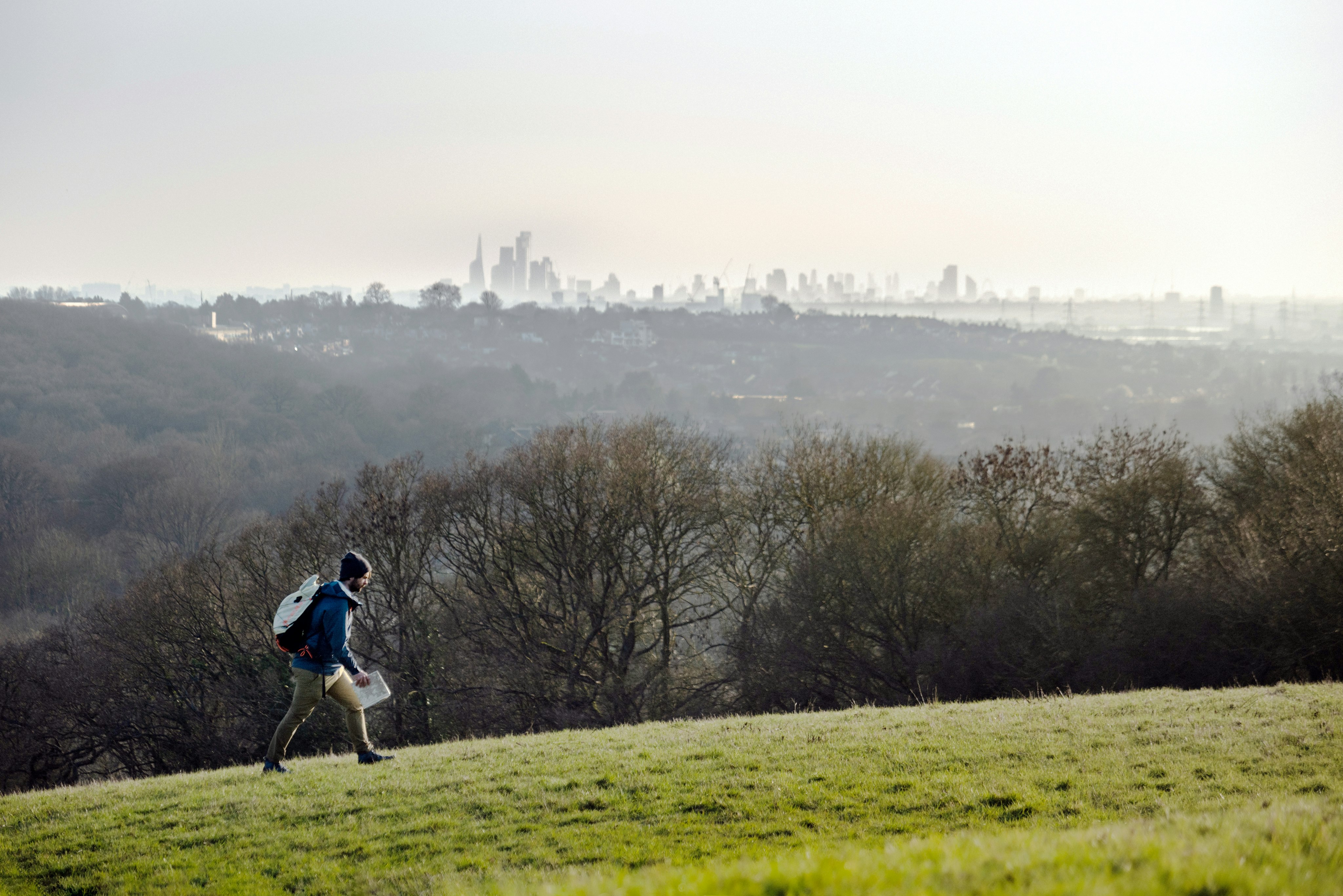An Outdoor Escape in London
04/2021

04/2021
@David McConaghy
David McConaghy
Oliver Smith
It’s never been more important for our mental well being that we find the time to venture outdoors and reap the benefits of fresh air and exercise. But with travel and even daily exercise severely limited, the outdoors has never seemed farther away for those in London.
While there aren’t any mountains to speak of or great lakes to circumnavigate within the capital, there are surprising pockets of nature hidden inside the M25. We sent North London local and outdoor and travel writer Oliver Smith to explore a corner of the city that’s provided him with an outdoor escape while his adventures across Britain and Europe were on hold—Epping Forest.
If you ever find yourself on a flight to Heathrow descending over London, peek out the window on the right (soon after the seatbelt sign goes bing). Circling high among the clouds, the most impressive sight in the capital isn't Big Ben, Buckingham Palace – nor even the dome of St Paul’s. It is the green sweep of Epping Forest: one of England's last great ancient woodlands. It is a pocket Amazon that, by some strange accident of geography, has snuck inside the M25. Epping Forest is a long thin wedge running roughly north-south: in the far north it is a backdrop to an Essex countryside of church bells, hedgerows and bowls clubs. In the south, its falling leaves scatter over inner city London: roundabouts, car parks, mosques with gilded domes, streets where the smell of fresh naan wafts through the air. It is mostly described as a wood on the edge of London. But seen from the passenger seat of a descending plane, it looks more like a wood travelling into London: a green dagger, plunging into the urban sprawl.
"The achievement in the Epping is briefly forgetting about the city and the world, and getting hopelessly, gloriously lost."
The forest is near my house and I go walking there often. In 2020 I had planned hiking trips to Snowdonia, the Scottish Highlands and the Alps – but travel bans meant Epping Forest ended up being the stand-in wilderness every time. It is a landscape with a very different set of rules for a walker. Trekking in the mountains means always being aware of your location: constantly making navigation decisions. Amongst the thickets and thorns of these woods, you can rarely follow the needle of the compass but instead must obey the path as it unravels before you. The triumph of a mountain walk is making the summit. The equivalent achievement in the Epping – to my mind, at least – is briefly forgetting about the city and the world, and getting hopelessly, gloriously lost. One place you can't get lost is Queen Elizabeth's Hunting Lodge – a three-storey tower on the threshold of the forest, which marks the starting point for my walk. Its name is misleading – the lodge was actually built during the reign of Henry VIII when Epping Forest was a royal forest. Some say the King shot passing deer from the windows in a spectacularly lazy kind of hunting. In the same spirit of royal laziness, legend also tells Queen Elizabeth rode up the stairs on her horse.
I carry on north – through Chingford Plain, past the reedy banks of Connaught Water. This stretch of Epping Forest I think of as the sunniest, jolliest corner of the woods. It has tarmac paths, meadows where wildflowers bloom in summer – it could be a backdrop for the Teddy Bear's Picnic. A labradoodle puppy splashes in the puddles and there is the distant jingle of an Ice Cream van. In his 1722 book, A Journal of a Plague Year, Daniel Defoe describes a group of Londoners who escaped the bubonic plague by fleeing to Epping Forest. 299 years on, the same thing has happened. Throughout Covid-19 Londoners have flocked to Epping Forest for their daily exercise: to charge their lungs with green air and roam wide open spaces. Eventually I reach Grimston's Oak – a hulking tree that guards a crossroads in the woods. North of here, Epping Forest starts to subtly change character. The paths turn muddier, holly bushes become denser. It is less Farthing Wood – more the forests of Tolkien, or perhaps Brothers Grimm. Walkers too, become scarcer. Legends, on the other hand, multiply.
A few miles away is the Iron Age hillfort of Ambresbury Banks – local folklore tells it was here that Boudica, Queen of the Iceni tribe made her last stand against the invading Romans in AD61. She incurred the wrath of the Romans by ransacking their decade-old city of Londinium – turning its temples and forums to ashes, and torturing its inhabitants. After some Imperial headscratching, the Romans decided to rebuild London: today it is a city of nine million souls. Ambresbury Banks, meanwhile, has been left as it was: a few lonely bumps in the earth, visited mostly by snuffling badgers. I soon come to another Iron Age hillfort: Loughton Camp, overgrown with beech trees. This part of Epping Forest was famously stomped by Dick Turpin – the flamboyant 18th century highwayman who robbed wayfarers on the road to London, before vanishing into the undergrowth and stashing his loot in a secret cave. The cave hasn't been found – a rational mind might question if it ever existed – but woods do funny things to rational minds, and people hunt for Turpin's cave at Loughton Camp to this day. Myths that would have withered and died in London's tarmac hold deep roots in these woods: they still flower as they pass from one generation to the next.
"Myths that would have withered and died in London's tarmac hold deep roots in these woods: they still flower as they pass from one generation to the next."
Epping Forest has long been a blind spot where Londoners have come to hide crimes and misdeeds. As soon as you enter the forest it plays pranks on your perspective. Your sightlines are blocked by the tangle of trunk and root, the mesh of leaf and branch. You come to suspect something is unfurling in the corner of your eye. The dash of a fallow deer. The bushy tail of a red fox. A glint of treasure from a secret cave. And, after a few hours – semi-lost, scrunching through leaf litter with only the trees for company – the scale of Epping Forest swells outward in your imagination too. Rather than a 6,000 acre wood within the M25, you wonder if you might be treading through an infinite, primeval forest – all England as it might have once existed before highways, Tudor hunts and Romans centurions. A place even before the swing of the first farmer's axe.
And as soon as Epping Forest casts this magic illusion, the spell is broken. With no warning, you crash out of the woods straight into a petrol station, a kebab joint, an audience of gnomes in a suburban garden. In my case, I burst out of a thicket straight into The Robin Hood – the pub on the A104 where travellers in Epping Forest have rested since the days of horse-drawn coaches. Today visitors are greeted by the benign gaze of golden buddhas, and the aroma of ginger and coriander. The pub is now an excellent Thai restaurant: I get a takeaway jungle curry and eat it sitting on a log nearby. In a very small way, it conjures up the rainforests of South East Asia out in the rainy forests of South East England. After lunch I bear west – stepping out of the heart of the forest, and towards a spine of hills looking over the capital – Lippits Hill, Yardley Hill, Pole Hill. Dense woodland turns to a smattering of copses. The silhouettes of The Shard, The Gherkin and Canary Wharf appear and disappear amongst the tallest pines. Muntjac deer skip about the thickets and daffodils sprout by country lanes. A woodpecker rattles away somewhere out of sight.
Due south from here, the meridian line stretches into central London, France, Spain and the faraway Sahara. Due north, it reaches through the western tip of Epping Forest and up to the frozen roof of the planet. It is strange to think that the invisible line by which the world sets its clocks runs through these woodlands – where the oaks measure passing centuries in concentric rings of growth, and time itself seems to tick by more slowly. I descend Pole Hill into Chingford and soon the sounds of the city resume – the rumble of traffic, the screeching brakes of a commuter train. As dusk descends, there's a new addition to this symphony of London sounds – the putter of a helicopter. The Metropolitan Police have long launched their helicopters from airfields on the edge of Epping Forest. I jealously imagine the pilots' view from the cockpit tonight: lifting off into cool spring air to see the electric lights of the capital glittering below them: a God-like perspective on houses and gardens, palaces and skyscrapers. And directly below them, will be the dark void of Epping Forest: one last part of the city into which they cannot see.
